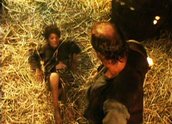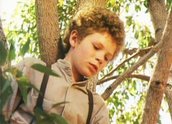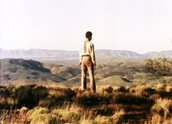


A Fortunate Life (1985)
Synopsis
A dramatisation of Albert Barnett Facey’s award-winning, widely read autobiography of the same name, this mini-series covers about three-quarters of the book. It begins with Facey’s arrival as a toddler in Western Australia in 1899, traces the various physical and emotional traumas of his childhood and adolescence, his adventures as a young adult trying to keep his head above water amidst the social and economic upheaval that marked the early years of the 20th century, and ends with his marriage to Evelyn Gibson (Nikki Coghill) in 1916, just a year after he had been badly injured during the Gallipoli campaign of the First World War.
Giving some idea of the breadth of this epic series is the fact that Albert Facey, or ‘Bertie’, is played by no less than five actors: at age 5, Scott Bartle; 9, Anthony Richards; 14, Benedict Sweeney; 18 plus, Dominic Sweeney; and at 70 plus, Bill Kerr.
Curator’s notes
The mini-series of A Fortunate Life was more than two years in the making, with much time and care having been spent on the adaptation of book to screenplay, and in pre-production on getting the historical detail, locations and scheduling right. To put it in perspective, this series of eight commercial hours is the equivalent in length of four feature films and in production terms at least as challenging. It succeeds on several levels.
The first is in telling the deeply personal story of a life lived with quiet, almost self-effacing courage. On another level the mini-series is a pictorial history of a period of great economic, social and industrial change in Western Australia. The years between Bertie’s arrival in 1899 and his marriage in 1916 saw the arrival of independent state government; the expansion of the Kalgoorlie goldfields, still considered to contain the richest square mile in the world; the opening up of the fertile south-west corner of the state to settler farmers; the building of the railway between Perth via Kalgoorlie to Port Augusta in South Australia, thereby connecting Australia’s newest and most isolated state capital with the rest of the continent; the difficult birth of the union movement in a part of Australia that still celebrates eccentric individualists; and the advent of the First World War, during which the enduring mythology of the Anzac was formed. All this features in the series.
It’s a broad canvas, one on which close attention has been paid to detail. In many ways the star of the show is its production designer, the late David Copping. With his skilled and hardworking team he re-created gold diggings, country towns, frontier farms, steam railways, drovers’ camps, even the battlefields of Gallipoli, not to mention interiors of everything from a cottage to a fairground bare-knuckle prize-fighting venue. Henri Safran, director of parts one and four, remarked that in three weeks of shooting on the Cave Rock set (see clip one) he never once had to put the camera down in the same place, a tribute to the visual possibilities created by the design team. Marcus Cole, who directed parts two and three, remembers that Copping ‘was wonderful and never faltered, never disappointed me and always gave more than he promised’.
Facey’s autobiography was published in 1981 (nine months before his death). Writer Ken Kelso, a West Australian himself, optioned the screen rights when it was still a virtually unknown ‘memoir’. The making of the mini-series kicked off when he enlisted the help of fellow AFTRS graduate Marcus Cole. Cole had recently been working for first-time producer Ian Bradley on the now iconic Australian television serial Prisoner (1979-86). Bradley was about to join PBL to head up its new division, PBL Productions, and brought the property with him. Cole took on the role of script and story editor on the project long before he was engaged as one of its two directors. Cole recalls that the writing process took the better part of a year and was, in his opinion, even more of a challenge than the actual shoot.
Bradley contracted Bill Hughes to produce the show. In an interview with ASO, Bradley said, ‘Bill had just finished directing the telemovie High Country (1984) which I wrote. I was so impressed by his approach that I offered him the opportunity to produce this mini-series. His attention to detail was always meticulous and paved the way for his later successes with projects like Phoenix (1992-93), The Interview (1998) and Changi (2001).’ Just as importantly, Hughes himself was willing to take on the risky business of overseeing this huge project, even if it was his first gig as producer.
In the meantime, Bradley went about the task of ensuring sufficient funding to allow the series to be shot in Western Australia. The cost of transporting and accommodating cast and crew some 3,000 or more kilometres from PBL’s home base on the eastern seaboard, and the fact that there was practically no infrastructure for a film industry in WA at the time, were obvious arguments against this move. Nevertheless, both Bradley and Hughes felt strongly that visual authenticity was very important and that it would be a large waste of time and money to attempt to cobble together various eastern Australian locations in an attempt to reproduce what was unique to WA. Again, it is a testament to the respect with which the material was treated and the fundraising potential of the 10BA tax scheme, then in operation, that their argument prevailed. It was soon vindicated in practical terms.
Hughes had hired David Copping as his production designer. Fresh from Breaker Morant (1979), for which he won an AFI Award, and with other prestigious credits including Storm Boy (1976), Picnic at Hanging Rock (1975) and Sunday Too Far Away (1975), it was nevertheless a novelty for Copping to be allowed a whole four month’s pre-production. Based in Western Australia, he soon found that there was a wealth of infrastructure still in existence that had enabled the social and industrial explosion earlier in the century. Given the time to search out locations, source, rebuild and repair century-old furniture, buildings and equipment, his team came up with water compressors, gold crushers, steam-driven tractors, trains and all matter of paraphernalia from life in the 1900s, which were not simply reproductions but often a resurrection of the original.
Furthermore, it seemed, everyone was eager to please. Fremantle City Council stopped work for an entire day on a marina construction project so that the crew could film without pile-drivers hammering in the background. Derrick Chetwyn, in charge of props and set dressing, noted that when he couldn’t find things he needed, Perth dealers would buy them through their own contacts and sell them to him for what they’d paid. The Kalamunda Historical Society made its entire museum available. Bruce Finlayson, wardrobe master, whose credits include Careful He Might Hear You (1983) and Bodyline (1984), described his task of producing literally hundreds of pieces of period clothing as ‘all straight sailing’, despite the fact that only one member of his department had had any previous film, television or theatre experience.
Warehouses at Kewdale, a light industrial area south-west of Perth, were converted into a studio complex housing offices, design workshops, props and wardrobe departments; one warehouse, on being lined with egg cartons, became a sound stage (see clip three). Editor Kerry Reagan got around the lack of suitable editing facilities by cutting on an Avid digital offline editing system, which he carried around in a couple of specially built suitcases, the first person in Australia to use this now commonplace technique. And when the shooting schedule required that the wheat harvest in part two needed to be shot in November, after the real harvest was over, the team planted a seven-hectare site with 70-day wheat in time for it to be harvested on camera when required.
Finally, a word about the cast. There were more than 36 featured characters and at least 100 other speaking and non-speaking roles, plus extras. By the time casting began, the book was a bestseller and it was not difficult to persuade well-known actors to take part, no matter how brief or marginal the role (see clip one). A Fortunate Life benefited immensely from the expertise of actors like Kirsty Child, Peter Cummins, Willie Fennell, Bill Hunter, Val Lehmann, Ray Meagher, Carole Skinner, Martin Vaughan and Catherine Wilkins, to name just a few.
When asked about the title of his book, Facey said he really believed that his had been a fortunate life. While most viewers will be aware of a strong note of irony underlying the story, there is no doubt that in the final analysis it is one of hope, endurance and faith in humanity. Bert Facey died in 1982, knowing that his memoir was to be filmed but long before it was finished. I’m pretty sure he’d have approved.
A Fortunate Life aired on Channel Nine in January 1985 to record-breaking ratings in Western Australia – roughly equivalent to an audience share of 52% in today’s terms. And ratings then were only a count of the number of sets tuned in to the program, not a head count of viewers as is the norm today. The series was also received well in the rest of the country. Its budget of around $6.3 million was the largest to date for a one-off television drama and nearly twice that spent, on average, per mini-series in the ‘80s. Of course, on average, A Fortunate Life was also almost twice as long as any other mini-series.



